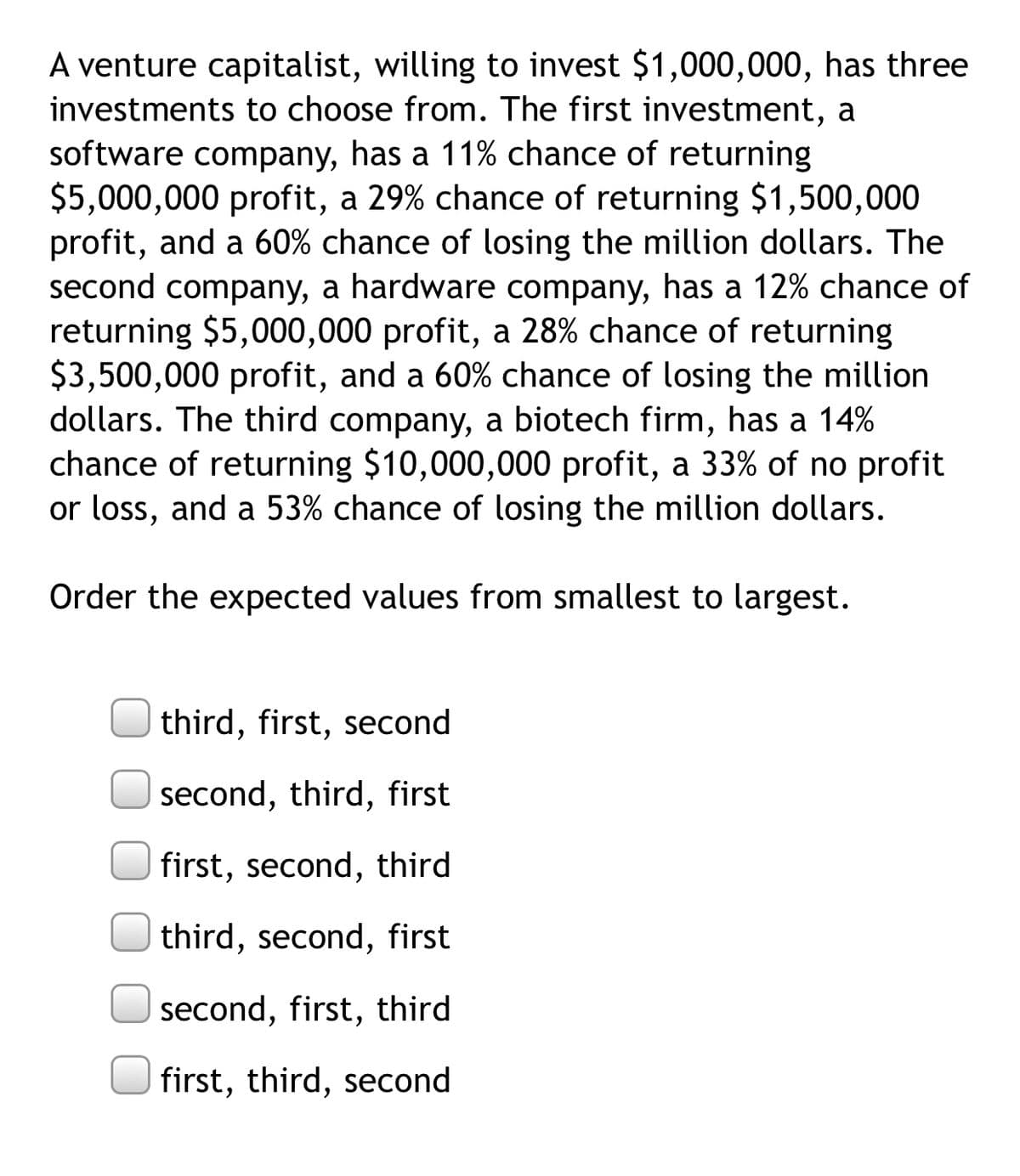A venture capitalist, willing to invest $1,000,000, has three investments to choose from. The first investment, a software company, has a 11% chance of returning $5,000,000 profit, a 29% chance of returning $1,500,000 profit, and a 60% chance of losing the million dollars. The second company, a hardware company, has a 12% chance of returning $5,000,000 profit, a 28% chance of returning $3,500,000 profit, and a 60% chance of losing the million dollars. The third company, a biotech firm, has a 14% chance of returning $10,000,000 profit, a 33% of no profit or loss, and a 53% chance of losing the million dollars. Order the expected values from smallest to largest. third, first, second second, third, first first, second, third third, second, first second, first, third first, third, second
A venture capitalist, willing to invest $1,000,000, has three investments to choose from. The first investment, a software company, has a 11% chance of returning $5,000,000 profit, a 29% chance of returning $1,500,000 profit, and a 60% chance of losing the million dollars. The second company, a hardware company, has a 12% chance of returning $5,000,000 profit, a 28% chance of returning $3,500,000 profit, and a 60% chance of losing the million dollars. The third company, a biotech firm, has a 14% chance of returning $10,000,000 profit, a 33% of no profit or loss, and a 53% chance of losing the million dollars. Order the expected values from smallest to largest. third, first, second second, third, first first, second, third third, second, first second, first, third first, third, second
Linear Algebra: A Modern Introduction
4th Edition
ISBN:9781285463247
Author:David Poole
Publisher:David Poole
Chapter2: Systems Of Linear Equations
Section2.4: Applications
Problem 28EQ
Related questions
Concept explainers
Contingency Table
A contingency table can be defined as the visual representation of the relationship between two or more categorical variables that can be evaluated and registered. It is a categorical version of the scatterplot, which is used to investigate the linear relationship between two variables. A contingency table is indeed a type of frequency distribution table that displays two variables at the same time.
Binomial Distribution
Binomial is an algebraic expression of the sum or the difference of two terms. Before knowing about binomial distribution, we must know about the binomial theorem.
Topic Video
Question

Transcribed Image Text:A venture capitalist, willing to invest $1,000,000, has three
investments to choose from. The first investment, a
software company, has a 11% chance of returning
$5,000,000 profit, a 29% chance of returning $1,500,000
profit, and a 60% chance of losing the million dollars. The
second company, a hardware company, has a 12% chance of
returning $5,000,000 profit, a 28% chance of returning
$3,500,000 profit, and a 60% chance of losing the million
dollars. The third company, a biotech firm, has a 14%
chance of returning $10,000,000 profit, a 33% of no profit
or loss, and a 53% chance of losing the million dollars.
Order the expected values from smallest to largest.
third, first, second
second, third, first
first, second, third
third, second, first
second, first, third
first, third, second
Expert Solution
This question has been solved!
Explore an expertly crafted, step-by-step solution for a thorough understanding of key concepts.
This is a popular solution!
Trending now
This is a popular solution!
Step by step
Solved in 4 steps

Knowledge Booster
Learn more about
Need a deep-dive on the concept behind this application? Look no further. Learn more about this topic, statistics and related others by exploring similar questions and additional content below.Recommended textbooks for you

Linear Algebra: A Modern Introduction
Algebra
ISBN:
9781285463247
Author:
David Poole
Publisher:
Cengage Learning

Linear Algebra: A Modern Introduction
Algebra
ISBN:
9781285463247
Author:
David Poole
Publisher:
Cengage Learning